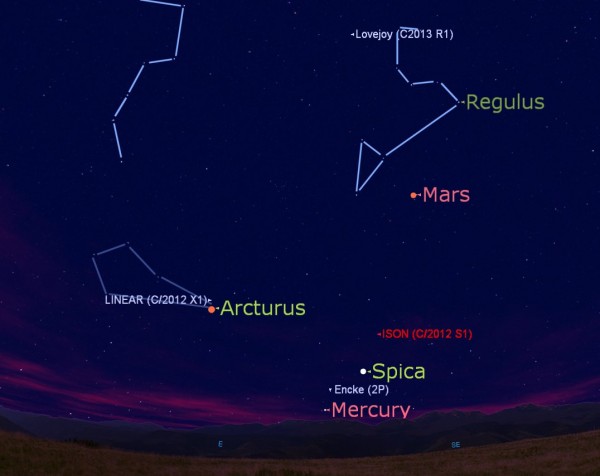
Backyard astronomers in the Northern Hemisphere get an eyeful this week, when four comets will be visible with binoculars or small telescopes in the early morning sky.
First up, the most famous of the bunch is Comet ISON, which is currently speeding towards its close encounter with the sun on November 28. While it has disappointed many for not being as bright, so far, as initially predicted it would be at this point in its orbit of the sun, it has in the last few weeks become a target visible in binoculars (Magnitude 8) from dark skies. (See also Comet ISON Plays Coy With Astronomers)
Look for it traveling through the constellation Virgo, in the low eastern sky from 1 to 2 hours before dawn.

On November 17 and 18, the comet will pose with the constellation’s brightest star, Spica, making it much easier to hunt down for sky-watchers in light-polluted areas.
Observers report that ISON sports a distinct ‘double’ tail, which is visible in photographs taken over the last few days. Both trail behind the comet’s fuzzy nucleus. One tail points directly away from the sun. It is made of ionized gas being swept away by solar wind. The second tail is composed of dust grains flying off the comet’s surface, and appears slightly curved. It follows the orbit of the comet.

Credit: Michael Jäger
Expectations are that ISON will continue to brighten as it approaches the sun, where hotter temperatures will start melting the icy interloper. Best views are expected after it has rounded the sun at the end of November—as long as it has not disintegrated from the scorching heat and intense gravitational pull of the sun. However, current predictions suggest that the comet will not attain the superstar status that it was once hoped for, such as becoming as bright as the moon. (See also: New Comet Discovered—May Become “One of Brightest in History”)
Since comets are notoriously unpredictable, there is still a chance it may become visible with the naked eye, putting on a nice sky show with a long, sweeping tail viewable in dark skies from December to January, as it heads back towards the outer solar system. (Related: Comet ISON: Pop or Fizzle?)
While Comet ISON has certainly been getting all the attention, another comet named Lovejoy is now actually outperforming it , shining nearly ten times brighter in the pre-dawn skies and is easily picked up in ordinary 7 x 50 binoculars.
To read the full article on the National Geographic’s Star Struck web page click here…

